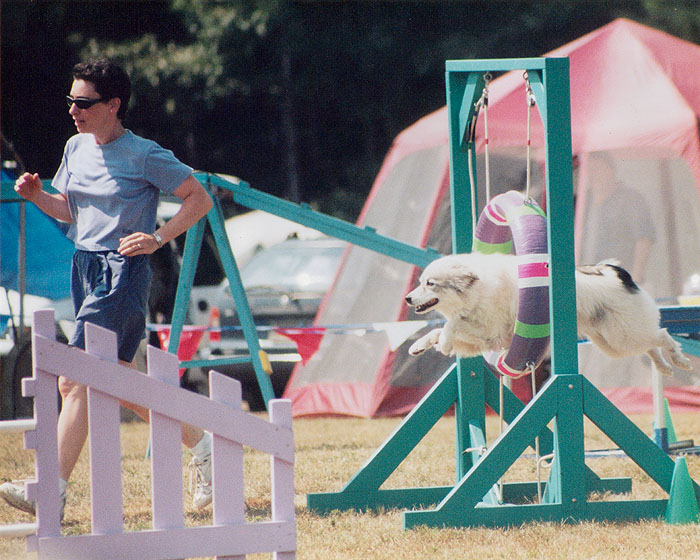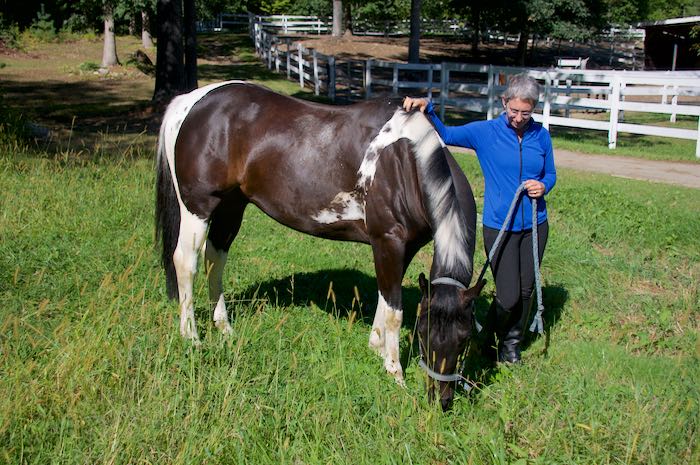Not quite twenty years ago, I had a dog that needed something to do. The sport of agility was beginning to gain popularity, and so I took classes and joined a club. I’d been a horsewoman, but found the change to a dog sport difficult. I wasn’t sitting on the dog and so couldn’t communicate by touch. I couldn’t use a leash or collar (the dog runs naked in the competition.) And in my club, we weren’t allowed to use the word no. It was all about positive reinforcement, and the principles of what we were doing were laid out in a book, Don't Shoot the Dog. Over the years, this type of training became more sophisticated and codified, and morphed into what is now known as clicker training. Using a small plastic noise maker, called a clicker, the trainer marks the moment that the animal does the right thing and then immediately gives the animal a reward (often, but not always, food.) Using clicker protocols, the training is efficient, precise and enthusiastically embraced by the learner. Decades of scientific research backs up why this method is so successful.

Nimbus and Terry on the agility course.
Clicker training has the potential to be very kind. There are no physical aversives – no whips, shock collars or twists to an ear. There are no verbal corrections. There should be (and this is hard to do) no negative body language by the trainer, no time-outs, no upping the criteria until frustration hits. Clicker training promises that you will have a mutually rewarding, generous and gentle relationship with your animal. For horse owners who have been told that they have to hit, yank and restrain their mounts, it can be such a relief to find out that there is another way.
But, horses are different than dogs. They are large and dangerous. A scared horse can swing into you and break a bone before you have a chance to react. The risk to all needs to be minimized by sensible and thoughtful handling and management. There are, of course, other differences between the species – from what motivates them to what they find frustrating. (A topic for an entire blog post – or several!) That said, bringing clicker training into your horse training works. Just like clicker training can be used to teach a tiger to offer her tail through a fence for a blood draw, an elephant to lift a foot for a pedicure, and a border collie to do a course of fifteen obstacles accurately at lighting speed, so can clicker training work to get a recalcitrant horse into a trailer, a young horse to willingly accept the saddle, or a dressage horse do a flying change.
But, before you pick up a clicker, learn the science behind it. (This book is the place to start.) Using the clicker takes some coordination and observational skills. Before applying it to your horse, train your dog, your guinea pig, your cat (oh, yes, it works!) Play the training game with your children. Embrace the perspective that it is the reward, not the correction, that drives behavior. Have fun.
Finally, before picking up the clicker, evaluate your relationship with your horse, and also your horse’s lifestyle. Most horses are kept at boarding barns, where other people do the feeding and handling, and so even if you switch to all positive reinforcement, that’s not your horse’s entire world. What the rest of his day is like will impact on how receptive he is to the time that you work with him. Is he hungry or able to graze 24/7? Does he have friends or is he kept in a separate paddock and so has no one (other than you) for mutual grooming? Is he bored? How much exercise does he get? What is he fearful of and why?
For most of us, our time with our horses is limited. Unlike our dogs, our horses don’t sit on our laps when we watch tv or climb into bed with us. Our relationship is reduced to an hour or so a day when we can get to the boarding stable. We don’t have the on-going and casual communication that happens when you live with your pet. Some horses get attention only when tacked up and ridden. Even if you clicker train, your time with your horse can be all about getting and training behavior. Sometimes we are so into the training that we lose sight of how demanding it is. Horses are cooperative animals who thrive on friendship. Given their druthers, they would spend hours a day, companionably grazing next to a friend. We can’t do that. I can’t do that. But I can carve out an extra half-hour to hand-graze my horse, not asking anything of him.

Then we can get to work.

Very interesting and informative post. You have a wonderful relationship with Tonka. Jess is loving helping the lady with her horses, still getting to grips with the different way of riding. No bit in mouth, different saddle, leaning forward, totally different a lot to learn…:)
I am not a horse person but so enjoy your posts about Tonka. In every post I learn something new. It seems to me that you and Tonka are quite a team. You have the time to concentrate and enjoy him only. No other worries for the time away. Besides being outside at this glorious time of the year it is a win….win! You are such an inspiration!
Sad news about Miss Nancy.
I’m glad to hear that my readers remain interested even when I veer off from the topic of chickens :)
Yep. The more time I spent on the ground with a horse, the better the horse would go for me. I used to do horrible, awful things, like take the horse down to the creek to play and splash in the water. Caught a lot of hell for ‘spoiling the horses’ and ‘wasting time’. And yet, they behaved better, not worse. My father used to say, “You get out of an animal what you put into an animal.” Yep.
Good dad.
My favorite poem from childhood:
I wish that my room had a floor
I don’t care so much for a door
But this walking around without touching the ground
Is getting to be quite a bore.
Looks like not touching the ground is lots more fun if you’re outside with your dog (not touching the ground).
Being with that dog was always fun.
When I took my youngest Golden Retriever to dog training it was with clicker training. It worked like a charm and actually we only used the clicker at the beginning. Once he learned his commands, the clicker was no longer necessary. I come across the clicker from time to time and if I just click it once all my dogs come running even the ones that did not do the clicker training. Once in front of me, they all wait patiently for that small treat I give them. I have to say Farley, my Golden, is probably the best behaved of any Golden I have raised. When you put a leash on him, it is as if he comes to attention. I have only good things to say about clicker training.